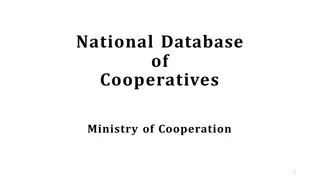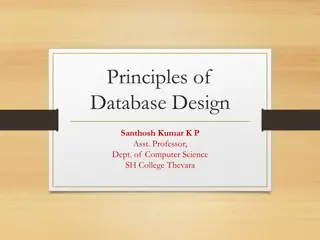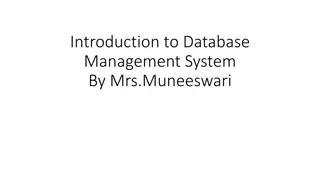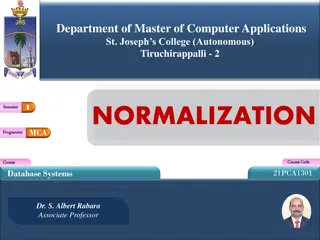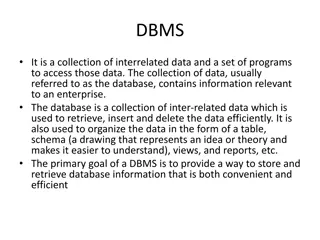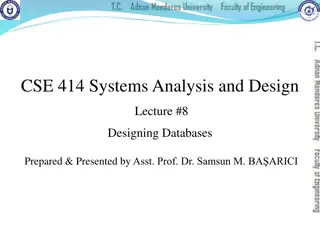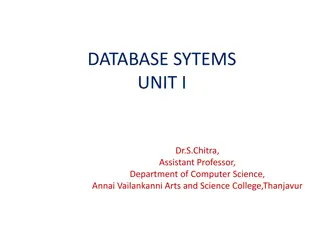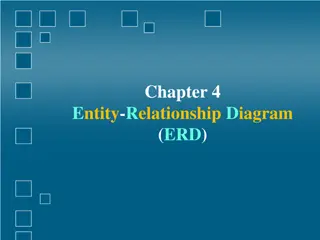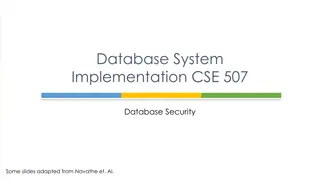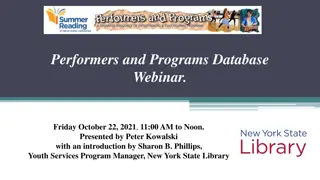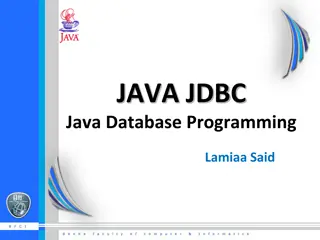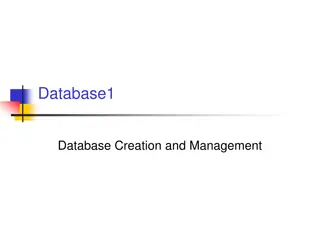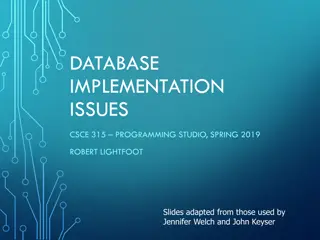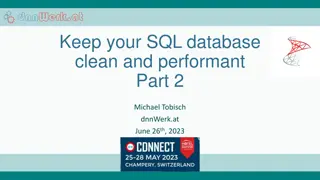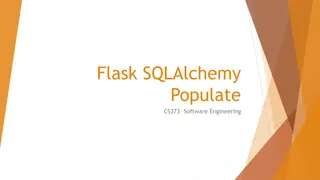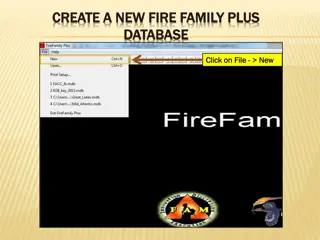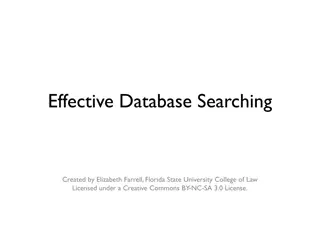Database searching
In the field of bioinformatics, database searching plays a crucial role in gene sequence analysis. This involves techniques like the Smith-Waterman algorithm and BLAST, which help researchers identify, compare, and classify genes efficiently. The article discusses the challenges of searching through vast databases, the development of faster heuristic approaches, and the working principles of tools like FASTA and BLAST. These tools utilize specific algorithms and terminology to improve speed and accuracy in identifying gene sequences.
Download Presentation

Please find below an Image/Link to download the presentation.
The content on the website is provided AS IS for your information and personal use only. It may not be sold, licensed, or shared on other websites without obtaining consent from the author.If you encounter any issues during the download, it is possible that the publisher has removed the file from their server.
You are allowed to download the files provided on this website for personal or commercial use, subject to the condition that they are used lawfully. All files are the property of their respective owners.
The content on the website is provided AS IS for your information and personal use only. It may not be sold, licensed, or shared on other websites without obtaining consent from the author.
E N D
Presentation Transcript
Why database searching? 1. To discover or verify identity of a newly sequenced gene 2. To find other members of a multigene family 3. To classify groups of genes
Database searching One approach use Smith-Waterman algorithm to find local alignments that compare query sequence to each sequence in database Problem: databases are huge (GenBank 82853685 (Feb 15 2008) sequences, Swiss- Prot: 5395414 sequences) S-W is slow (O(Nn2)) where n is the sequence length and N is the number of sequences in the database Solution: use faster heuristic approaches FastA Blast Constant tradeoff: sensitivity vs. false-positives Smith-Waterman is slower, but more sensitive
BLAST Basic Local Alignment Search Tool Developed in 1990 by Altschul, Gish, Miller, Myers and Lipman Motivation: Available algorithm was still too slow Altschul et al. reasoned that speed could be increased by finding fewer, but better, hot spots during the initial screening phase Uses longer word sizes (ktup length) Main idea: integrate the substitution (scoring) matrix into this first phase BLAST explicitly designed for protein alignments FASTA originally developed for DNA, now most widely applied to proteins
BLAST Terminology: Segment pair = pair of equal-length substrings of sequences S1 and S2 Locally maximal segment pair = segment pair whose alignment score cannot be improved by extending or shortening it Maximum segment pair (MSP) = segment pair with maximum score over all segment pairs in the sequences S1 and S2 BLAST attempts to find all database sequences that when paired with the query sequence contain an MSP above some cutoff score s - these segment pairs are called HSPs (high-scoring segment pairs) - s is chosen (obviously) so that it is unlikely that comparison of query sequence to unrelated sequences will achieve a score higher than s
BLAST Algorithm 1. Choose length parameter w and threshold parameter t: - Will find hits = all w-length substrings ( words ) in the database that align with words from the query sequence with an alignment score > t - Unlike FASTA, use scoring matrix to compare words rather than requiring exact matches (allows word size to be kept high for speed, without sacrificing sensitivity) - Typically, w = 3-5 for amino acids, ~11-12 for DNA - t is the most critical parameter: t background hits (faster) t ability to detect more distant relationships (at cost of increased noise)
BLAST Algorithm 2. Make a list of all words in the query sequence of length w before starting the database search 2. For each of these words, evaluate score of exact match according to BLOSUM62 matrix E.g., with w=3: P Q G P Q G 7+5+6 = 18 exceed t: greatly reduces number of possible matching words; e.g., PQG vs. PQA = 7+5+0 = 12 (DNA search uses only exact matches) Also calculate scores for nearby matches ( neighborhood ) that - E.g., 20w possible w-length words: if w=3, 203=8000 possible 3- residue words, but if only 50 achieve score > t, don t have to worry about the others
BLAST Algorithm 4. Search the database using a search-tree based method for rapid comparison to database i.e., preprocess databases to facilitate finding match scores to previously chosen search words 5a. Original BLAST method: The original version of BLAST stretches a longer alignment between the query and the database sequence in the left and right directions, from the position where the exact match occurred. The extension does not stop until the accumulated total score of the HSP begins to decrease. 5b. Gapped BLAST: - Uses 2-hit method (3X faster) - Was originally observed that extension step accounts for ~90% of BLAST s total execution time, therefore reduce number of extensions
BLAST Algorithm 5b. Gapped BLAST: - Uses 2-hit method (3X faster) - Was originally observed that extension step accounts for ~90% of BLAST s total execution time, therefore reduce number of extensions
BLAST Algorithm Gapped BLAST (cont.): Basic idea: - Do the extensions only when there are two hits on the same diagonal within some distance A of each other (e.g., A=40) - Reduces sensitivity (ability to detect distantly related sequences) Use lower t threshold parameter value (e.g., 11 rather than 13) Results in longer word list, but only extend if get two nearby hits, therefore many fewer regions are extended
BLAST Algorithm Gapped BLAST (cont.): When get a double-hit, do an ungapped extension to obtain an HSP Then attempt to extend regions of high similarity using dynamic programming algorithm, starting from center of each high-scoring region if s > sg (sg is chosen such that a gapped alignment is triggered in about 1/50 of the sequences compared) Original BLAST method treated gapped alignments by finding several distinct HSPs involving the same sequence, and calculating a statistical assessment of the combined result e.g., 2 or more HSPs each below the cutoff value might in combination rise to statistical significance In gapped BLAST, we extend hits by allowing gaps (slow) but only those hits that are promising (exceed sg): advantage is that can afford to miss some HSPs as long as at least one is found
BLAST Algorithm Gapped BLAST (cont.): Allows local alignments with indels (similar to FASTA where we joined diagonal runs from different diagonals) Local alignments from different diagonal are merged into a different local alignment followed by some indels followed by a second local alignment (etc.) equivalent to a path through the dynamic programming matrix composed of alternating diagonal sections and paths connecting them that may have gaps
BLAST Algorithm Gapped BLAST (cont.): List all of the HSPs in the database whose score is high enough to be considered. We list the HSPs whose scores are greater than the empirically determined cutoff score S. By examining the distribution of the alignment scores modeled by comparing random sequences, a cutoff score S can be determined such that its value is large enough to guarantee the significance of the remaining HSPs.
PSI-BLAST Position-specific iterated BLAST Useful, e.g., for finding all (including distantly related) members of a gene family Rather than searching for matches between a single query sequence and individual sequences from the database, compares query sequence to sets of related sequences Uses position-specific scoring matrices (PSSMs) that are constructed in successive iterations
PSI-BLAST General flow: 1. Find sequences related to some query sequence (E above some limiting value) 2. Compute local multiple alignments for these sequences 3. Calculate PSSM from amino-acid composition of columns in the multiple alignment 4. Use this PSSM to search database, possibly identifying new sequences. If set of matching sequences is expanded, return to step 2. Otherwise stop.
PSI-BLAST PSSM searching example (PSSM calculated from some region of local similarity; only relevant values are shown) A M P G V . 4 . . . . . . . . . . . . . . . . . . . . . . . . . . . . . . . 2 0 . . . . . . . . . . . . . . . . . . . . . . . . . . 1 2 . . . . . . . . . . . . . . . . . 3 -1 . . . . . . . . . . . . . . . . . . . . . . . . -1 3 . . . . . . . . . . . . . <-- A M P G V . A 4 . . . . . C . . . . . . D . . . . . . E . . . . . . F . . . . . . G . . 2 0 . . H . . . . . . I . . . . . . K . . . . . . L . . . . . . M 1 2 . . . . N . . . . . . Q . . . . . . P . 3 -1 . . . R . . . . . . S . . . . . . T . . . . . . V . . . -1 3 . W . . . . . . Y . . . . . . A C D E F G H I K L M N Q P R S T V W Y score = 4 + 2 - 1 + 0 + 3 + ... score = 1 + 3 + 2 - 1 + ... To search, slide PSSM down query sequence, computing score for each position... Highest scores represent best matches of the motif represented by the PSSM to the query sequence (preferentially rewards matches to columns that have a conserved amino acid relative to matches with highly variable columns, and conversely for penalizing mismatches)
LASTZ (Large-Scale Genome Alignment Tool) a fast and powerful alignment tool for the pairwise alignment of genomic DNA sequence. LASTZ was designed with large-scale genomic analysis in mind and can efficiently align chromosomal or genomic sequences millions of nucleotides in length. It identifies orthologous regions between genomic sequences on a massive scale using a methodology that ignores the coding-region bias.



